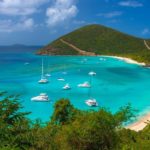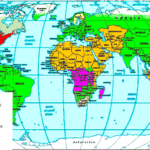Fantasy Islands
Edited by Richard Ammon
GlobalGayz.com
August 2017
The U.S. Virgin Islands are a collection of Caribbean islands with the most inhabited being Saint Croix, Saint John, and Saint Thomas. 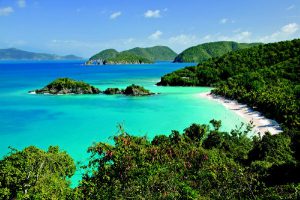 There are several smaller ones including Water Island and other surrounding minor islands. The total land area of the territory is 133.73 square miles with a population of about 106,000. (By contrast, the total area of New York City is 468.9 square miles with 8,300,000 people.) They were called the Danish West Indies before they were sold in 1917 to the United States by Denmark for $25 million, a year before the US entered World War I; the US feared the Germans would take the islands for use as a submarine base. Water Island did not become an official part of the VirginIsland until 1996. They are currently an organized, unincorporated United States territory.
There are several smaller ones including Water Island and other surrounding minor islands. The total land area of the territory is 133.73 square miles with a population of about 106,000. (By contrast, the total area of New York City is 468.9 square miles with 8,300,000 people.) They were called the Danish West Indies before they were sold in 1917 to the United States by Denmark for $25 million, a year before the US entered World War I; the US feared the Germans would take the islands for use as a submarine base. Water Island did not become an official part of the VirginIsland until 1996. They are currently an organized, unincorporated United States territory.
Most people think of the Islands as a slice of paradise, but they happen to lie in the middle of ‘hurricane alley’ and have been hit with ferocious storms five times since 1998 that have caused catastrophic physical and economic damage.
Tourism is the primary economic activity with about 2 million visitors a year, including those arriving on cruise ships, of which about 10% are gay cruises.
Manufacturing is present: petroleum refining, textiles, electronics, rum distilling, pharmaceuticals, and watch assembly. Agriculture business is small so most food is imported. International business and financial services are small–in contrast to the BVI where over 50% of income derives from the financial sector. St Thomas and St John are so close there’s a car ferry between them. To St Croix from St Thomas it’s 45 miles and there is ferry service as well as seaplanes that fly daily.
Most energy is fueled by imported oil resulting in electricity costs four to five times more than the mainland. Imported energy also operates the large desalination facilities. A local economic crisis struck since February 2012 when one of the world’s largest oil refineries located on Saint Croix shut down. Until then it had contributed about 20% of the territory’s GDP.
Gay Life
As for LGBT life in the USVI, the islands have a more distinct American feel than the BVI with more LGBT visibility even though there isn’t a LGBT center or a nightlife ghetto on any of the three islands. When LGBT tourists visit the British Virgin Islands and want more gay energy they go to Charlotte Amalie on St Thomas while others who want even more travel to Frederiksted on St. Croix which has more hotels and venues catering to the gay market.
St Thomas Island 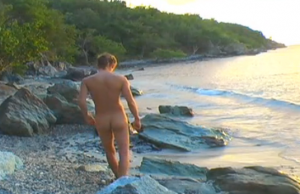
This is the most familiar and developed of the three Virgins. It boasts one of the most charming cities in the Caribbean, Charlotte Amalie, with its narrow alleyways of rainbow-colored houses along the harbor and into the hills. “While only about 20,000 people live here, there’s a real city bustle. One-time Danish warehouses stretch along quaint small streets, now filled with an attractive array of dining, drinking, and shopping places.” (From Passport Magazine)
“St. Thomas once had a thriving gay nightlife scene. That’s no longer the case, though you’ll find a gay-friendly atmosphere (and ‘down low’ action). “A lot of local men here are in the closet,” notes W. ‘Champagne’ Chandler, a longtime fixture of the St. Thomas’ gay scene. Another visitor noticed, “shops all over St. Thomas had rainbow stickers on their doors, and it wasn’t even a gay cruise that was in town. I was pleasantly surprised to see just how many shops were advertising for the gay dollar.”
GayTravel.com has this posted: “Most of the gay-specific bars and clubs have relocated to neighboring St. Croix, but that doesn’t mean there aren’t lots of options for gays and lesbians on St. Thomas. Some (not all) locals and most visitors tend to be liberal and open-minded, meaning the lack of gay venues on St. Thomas may have more to do with the fact that there is just no specific need for gay-oriented bars and clubs… Perhaps the most popular restaurant/bar/club for gay travelers is The Greenhouse that has a very diverse clientele and perhaps the best Happy Hour in St. Thomas. Come early, stay late.”
This is the island for kicking back and ‘doing nothing’ other than those ever desirable acts of reading, listening to music, swimming, snorkeling, slow dinners, walks on the beach and forgetting there is any other world than here. And maybe practicing up on one’s gaydar.
Saint John Island
A short pretty ferry ride goes from St. Thomas to sleepy Cruz Bay, St. John’s main settlement. It’s in much contrast with busy Charlotte Amalie. The ‘town’ has only a couple of streets, (there are only about 4200 full-time residents) but there are art galleries, restaurants, beachwear shops, rum watering holes and lots of appealing beaches with clear water for sports; it is indeed a funky little seaside town.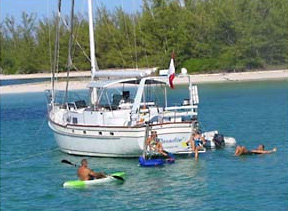
A national park occupies 60 percent of St. John’s area and invites exploration by foot or vehicle. “You’ll drink in the beauty whether you’re beach side or atop Bordeaux Mountain, St. John’s highest point. From here you can look out at a the stunning seascape framed by bougainvillea with several islands dotting the waters below.”
Chateau Bordeaux restaurant is where you’ll enjoy the panorama from the patio and dining room. Said the manager Paul Kessock, “We’re happy to do commitment ceremonies here, and local minister Ann-Marie Porter performs them. That’s to be expected on an island that’s so gay-friendly. It’s called Love City, after all,” smiles Kessock who commutes here daily from St. Thomas. “I’ve never had any problem at all on either island, and I’m an openly gay man.” (From Passport Magazine)
Needless say there is no gay ‘scene’ other than what you and your lover make it to be–or an accidental gaydar connection.
Saint Croix Island
“St. Croix is the most gay-friendly locale on the U.S. Virgins Islands. The LGBT infrastructure on St. Croix is limited but the island does have a gay hotel, a couple of gay-friendly clubs and a gay business guild. It remains a popular destination with gay locals and tourists alike. Cormorant Beach Club Restaurant & Bar is the island’s most popular gay bar and welcomes all patrons. The year-round population is about 56.000.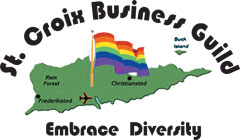
“In addition to beautiful bleaches St. Croix offers tours to plantation houses, rum factories and lush botanical gardens. Gambling is also legal on the island. In July is the Lifestyle Music Festival with many concerts. Gay-friendly yacht companies are located here. Cruise the open waters and take in the beautiful turquoise waters, gorgeous reef and swaying palm trees.
“St. Croix has nearly 100 miles of endless white beaches and is the least touristy of the three major American islands. There’s fine shopping, resorts and restaurants for visitors but if you like peace and quiet, there’s also plenty of rest here. (From GayTravel.com)
Passport magazine has this to say: “By far the biggest of the three U.S. Virgin Islands, St, Croix is mysterious and fascinating. The towns, Christiansted and Frederiksted, are not as developed as Charlotte Amalie and the countryside is still relatively au naturel.
“The two towns each town have a distinct personality, so most visitors try to get a taste for each one. From rum distilleries and plantations to nature reserves, there’s plenty to do and see. The most popular beach on St. Croix is Dorscht Beach. The beautiful views, crystal clear water and calming waves are intoxicating. This is also a great place to run into other gay and lesbian travelers on holiday.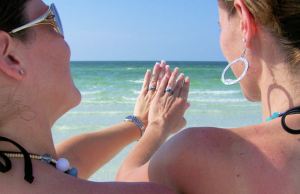
“If you are looking for more adventure, Buck Island is about four miles off of Christiansted. The area offers fabulous water sports and beach activities. The national monument on Buck Island is more than 800 acres of paradise for gay, lesbian and all other travelers alike. (From Passport Magazine)
“Quiet acceptance has made things relatively easy for the local GLBT community, one local resident said. “St. Croix has a way of making you feel like ‘family’ very quickly, and that includes everyone.” As she spoke she pointed out a lesbian couple sipping lattés, and a local gay lawyer getting takeout coffee.
“Photographer Ted Davis, who recently moved to St. Croix with his partner Sam Dike, agrees. “It’s been refreshing,” commented Ted, “there hasn’t been a single problem with being an openly gay couple.” Sam seconds the notion: “We don’t feel guarded at all. Everyone’s been extremely supportive.”
“Frederiksted, on the west coast, is a little sleepier. Here, Simone Palmer and Sheryl Smith run Sand Castle on The Beach Hotel, where a mixed, largely gay/lesbian crowd comes for west coast relaxation.
“January and February tend to have more gay men,” notes Simone, “while in spring we get more lesbians, as a rule.” But everyone is welcome, and there’s an easy bonding among all. For Simone, a member of the still-developing St. Croix Business Guild, an organization of lesbian/gay-owned businesses on the island with the motto “Embrace diversity,” this is an important function of the hotel. “It’s about building bridges,” she notes.”
Native Afro-Caribbean LGBT People
There are of course variations to the sexual experience in the Caribbean. It’s not all joyous suntanned tourists. An in-depth study in 2007 resulted in a book titled ‘Caribbean Pleasure Industry’ by Mark Padilla in which the author analyzes men who have sex with male tourists, yet identify themselves as “normal” heterosexual men and struggle to maintain this status within their relationships with wives and girlfriends… also his examination of bisexuality and tourism as much-neglected factors in the HIV/AIDS epidemic makes this book essential to anyone concerned with health and sexuality in the Caribbean or beyond.” (Published 2007)
Away from the tourist sex scene, which Padilla describes in his book, there are many Afro-Caribbean gay people who identify as gay and reject prostitution, who want to form a one-on-one serious long-term relationship with another native gay person, or with a mainlander in a bi-cultural relationship. Research for about native-islander gay-on-gay lives and experiences is not easy to find. It is not a well reported field despite the reality of many Afro-Caribbean and bi-cultural relationships in the Caribbean.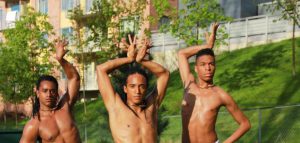
Life on the ‘Down Low’
Another variant of Caribbean sexuality can be read on a new online website called Discreet City, “the first online magazine created by and for Masculine Gay/Bisexual Men of Color.” One of their dozen-plus categories of information (politics, advice, health, social & travel, etc.) is Sex & Dating that includes talk about being on the ‘down low’, heterosexually married men who have sex with other men. Once a deep secret in the closet and underground, in recent years this has become widely known in the gay community–and among women and spouses.
For ‘down-low’ men (and women) in the homophobic Afro-Caribbean population in the Virgin Islands it is a way of life for survival’s sake as well as a way to find authentic pleasure (and love) while avoiding exposure and public shame. These folks are virtually invisible and very private. No one is going to reveal himself willingly; it’s secretive and plays on the edge of duplicity, deception and betrayal. It is emotionally stressful and is one of the worst consequences of the disease of homophobia.
A gay or lesbian tourist who happens to trick with a ‘down-low’ husband (or wife) is not likely to know the truth about their Mr/Ms Right-Now.
Modern Gay Tribulations
Another of Discreet City‘s categories is Advice to which the following plea was recently sent:
Dear Discreet City,
“I’m a 22-year-old, gay, Afro-Caribbean man living in the US Virgin Islands and I’m at my wits’ end in trying to find friendship and companionship. No visible community exists here and I haven’t found the so-called underground community either–yet. I lack friends who can truly understand me. Online attempts to find “friends” have been disappointing. Gay men (and women I suppose) here stay very closeted and don’t identify as gay or bisexual, so there’s no queer community for me to contact.”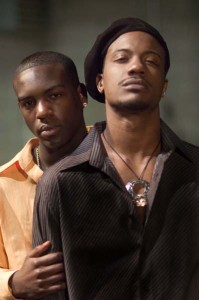
The adviser (edited here) goes on to say: “…being ‘down low’ no one is going to reveal himself easily; it secretive and that’s why it’s called that… Although friendship is supposed to enhance your life, allowing yourself to be dependent on them for your own happiness is not a healthy way to live… You are responsible for your own happiness not the people you meet. Solitude and isolation, for now; they can give you time to strengthen yourself mentally, physically and spiritually (build self-confidence) so when you do come across potential people who you may want to explore friendship or intimacy with, you will be more grounded and more secure (proud) to recognize genuine people to allow into your space…”
The second half of the reply urges Mr Lonely-heart to “come up with a plan to break out and away from your island and live abroad… Don’t just think about DC or NYC, but also about Canada and other countries in Europe where it may be easier to obtain citizenship or work visa status. Or what about other islands like Trinidad and Tobago, which is closer to you and where there’s a bigger and more visible gay scene than any other regional country except Puerto Rico?…”
Other LGBT Locals
Not all Afro-Caribbean LGBT people in the islands are wrapped in loneliness and hide in the down-low as these supportive words from natives testify: “I have two gay people in my family and when we have family gathering they bring their partners along”. “We live in a free country. if this is the way people choose to live their lives let them. I would be very upset if someone would try to dictate how I should live my (straight) life”. “I don’t condone the lifestyle, but family is family. If that is his only fault, then I don’t think it has anything to do with his capabilities as an uncle, cousin, or etc, and I would still permit him around my kids.”
In 2008 a book by Claude Douglas, ‘Homosexuality in the Caribbean–Crawling Out of the Closet‘ examined the rise of this alternative lifestyle in the region. Douglas says: …”there is not an increase in the number of homosexuals in the Caribbean but more are finding the courage to come out; some of the key factors affecting this lifestyle include the campaign of the gay-rights movement on the mainland… despite this some local people don’t like to hear that homosexuality is becoming an alternative and acceptable form of human sexuality in the Caribbean. but here we are anyway.” As elsewhere in the current world, times are changing which many people embrace and others fear.
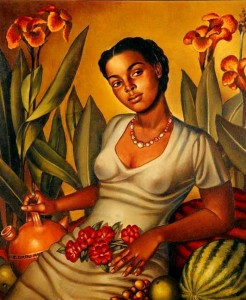 Finally
Finally
Whatever the particular type of experience a visitor or native is looking for in the Virgin Islands he or she is likely to find it. From sunshine and water skiing, cocktails and cruising, to after-hours nocturnal intimacy, gay, straight or in-between, Afro-Caribbean or gringo, out proud or down-low, there is plenty of diversity in the Caribbean Virgin Islands, UK and USA.
Since there are many similarities in culture, law, attitudes, weather and proximity between the British and American Virgin Islands, many of the preceding observations about LGBT life in the USVI also apply to the BVI. Reading both stories offers useful insight into these ‘paradise islands’ and the popular gay tourist scene as well as not-so-easily-seen Afro-Caribbean gay lives.
Also:
http://www.islandmix.com/backchat/f9/gay-men-caribbean-27490/
http://glq.dukejournals.org/content/18/2-3/277.abstract
http://www.gotostcroix.com/

